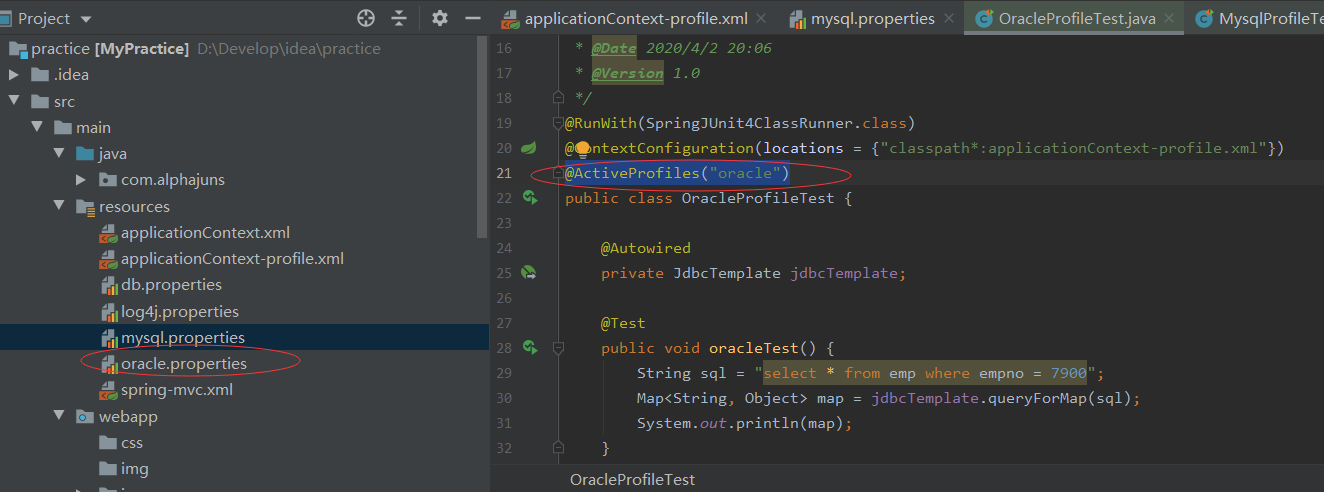SpringBoot指定数据源配置
1.结合junit加载数据源
开发、测试、生产都有各自的数据库,这样需要配置的数据源不一样。
每次部署时修改配置过于繁琐,此时,
可以使用Spring的Profile来配置多个数据源,运行前指定需要加载的数据源即可。 采用spring结合junit做演示,使用oracle和mysql做数据源区别演示,
Profile名指定为oracle和mysql,junit测试时,
使用@ActiveProfiles("mysql"),@ActiveProfiles("oracle")来指定需要加载的数据源。

ps:激活指定Profile,junit使用@ActiveProfiles("oracle")
2.了解Profile
(1)Spring中的Profile定义 Spring中的Profile功能其实早在Spring 3.1的版本就已经出来,
它可以理解为我们在Spring容器中所定义的Bean的逻辑组名称,
只有当这些Profile被激活的时候,才会将Profile中所对应的Bean注册到Spring容器中。
举个更具体的例子,我们以前所定义的Bean,当Spring容器一启动的时候,
就会一股脑的全部加载这些信息完成对Bean的创建;而使用了Profile之后,
它会将Bean的定义进行更细粒度的划分,将这些定义的Bean划分为几个不同的组,
当Spring容器加载配置信息的时候,首先查找激活的Profile,
然后只会去加载被激活的组中所定义的Bean信息,
而不被激活的Profile中所定义的Bean定义信息是不会加载用于创建Bean的。
(2)使用Profile
由于我们平时在开发中,通常会出现在开发的时候使用一个开发数据库,
测试的时候使用一个测试的数据库,而实际部署的时候需要一个数据库。
以前的做法是将这些信息写在一个配置文件中,当我把代码部署到测试的环境中,
将配置文件改成测试环境;当测试完成,项目需要部署到现网了,
又要将配置信息改成现网的,真的好烦。。。
而使用了Profile之后,我们就可以分别定义3个配置文件,
一个用于开发、一个用户测试、一个用户生产,
其分别对应于3个Profile。当在实际运行的时候,
只需给定一个参数来激活对应的Profile即可,
那么容器就会只加载激活后的配置文件,
这样就可以大大省去我们修改配置信息而带来的烦恼。
(3)配置Spring profile
在介绍完Profile以及为什么要使用它之后,
下面让我们以一个例子来演示一下Profile的使用,
这里还是使用传统的XML的方式来完成Bean的装配。
第一步:Maven依赖
由于只是做一个简单演示,因此无需引入Spring其他模块中的内容,
只需引入核心的4个模块+测试模块即可
<properties>
<project.build.sourceEncoding>UTF-8</project.build.sourceEncoding>
<!--指定Spring版本,该版本必须等于3.1-->
<spring.version>4.2.4.RELEASE</spring.version>
<!--指定JDK编译环境-->
<java.version>1.7</java.version>
</properties>
<dependencies>
<dependency>
<groupId>org.springframework</groupId>
<artifactId>spring-core</artifactId>
<version>${spring.version}</version>
</dependency>
<dependency>
<groupId>org.springframework</groupId>
<artifactId>spring-beans</artifactId>
<version>${spring.version}</version>
</dependency>
<dependency>
<groupId>org.springframework</groupId>
<artifactId>spring-context</artifactId>
<version>${spring.version}</version>
</dependency>
<dependency>
<groupId>org.springframework</groupId>
<artifactId>spring-expression</artifactId>
<version>${spring.version}</version>
</dependency>
<dependency>
<groupId>org.springframework</groupId>
<artifactId>spring-test</artifactId>
<version>${spring.version}</version>
<scope>test</scope>
</dependency>
<dependency>
<groupId>junit</groupId>
<artifactId>junit</artifactId>
<version>4.12</version>
<scope>test</scope>
</dependency>
</dependencies>
<build>
<plugins>
<plugin>
<groupId>org.apache.maven.plugins</groupId>
<artifactId>maven-compiler-plugin</artifactId>
<version>2.3.2</version>
<configuration>
<source>${java.version}</source>
<target>${java.version}</target>
</configuration>
</plugin>
</plugins>
</build>
第二步:例子代码
package com.panlingxiao.spring.profile.service; /** * 定义接口,在实际中可能是一个数据源 * 在开发的时候与实际部署的时候分别使用不同的实现 */ public interface HelloService { public String sayHello(); }
定义生产环境使用的实现类
package com.panlingxiao.spring.profile.service.produce; import org.springframework.beans.factory.annotation.Value; import org.springframework.stereotype.Component; import com.panlingxiao.spring.profile.service.HelloService; /** * 模拟在生产环境下需要使用的类 */ @Component public class ProduceHelloService implements HelloService { //这个值读取生产环境下的配置注入 @Value("#{config.name}") private String name; public String sayHello() { return String.format("hello,I'm %s,this is a produce environment!", name); } }
模拟在开发环境下需要使用的类
package com.panlingxiao.spring.profile.service.dev; import org.springframework.beans.factory.annotation.Value; import org.springframework.stereotype.Component; import com.panlingxiao.spring.profile.service.HelloService; /** * 模拟在开发环境下使用类 */ @Component public class DevHelloService implements HelloService{ //这个值是读取开发环境下的配置文件注入 @Value("#{config.name}") private String name; public String sayHello() { return String.format("hello,I'm %s,this is a development environment!", name); } }
定义配置Spring配置文件
<?xml version="1.0" encoding="UTF-8"?> <beans xmlns="http://www.springframework.org/schema/beans" xmlns:xsi="http://www.w3.org/2001/XMLSchema-instance" xmlns:context="http://www.springframework.org/schema/context" xmlns:util="http://www.springframework.org/schema/util" xsi:schemaLocation="http://www.springframework.org/schema/beans http://www.springframework.org/schema/beans/spring-beans-4.2.xsd http://www.springframework.org/schema/context http://www.springframework.org/schema/context/spring-context-4.2.xsd http://www.springframework.org/schema/util http://www.springframework.org/schema/util/spring-util-4.2.xsd"> <!-- 定义开发的profile --> <beans profile="development"> <!-- 只扫描开发环境下使用的类 --> <context:component-scan base-package="com.panlingxiao.spring.profile.service.dev" /> <!-- 加载开发使用的配置文件 --> <util:properties id="config" location="classpath:dev/config.properties"/> </beans> <!-- 定义生产使用的profile --> <beans profile="produce"> <!-- 只扫描生产环境下使用的类 --> <context:component-scan base-package="com.panlingxiao.spring.profile.service.produce" /> <!-- 加载生产使用的配置文件 --> <util:properties id="config" location="classpath:produce/config.properties"/> </beans> </beans>
说明:
开发使用的配置文件,dev/config.properties
name=Tomcat
生产使用的配置文件,produce/config.properties
name=Jetty
编写测试类
package com.panlingxiao.spring.profile.test; import org.junit.Test; import org.junit.runner.RunWith; import org.springframework.beans.factory.annotation.Autowired; import org.springframework.test.context.ActiveProfiles; import org.springframework.test.context.ContextConfiguration; import org.springframework.test.context.junit4.SpringJUnit4ClassRunner; import com.panlingxiao.spring.profile.service.HelloService; @RunWith(SpringJUnit4ClassRunner.class) @ContextConfiguration(locations="classpath:spring-profile.xml") /* * 使用注册来完成对profile的激活, * 传入对应的profile名字即可,可以传入produce或者dev */ @ActiveProfiles("produce") public class TestActiveProfile { @Autowired private HelloService hs; @Test public void testProfile() throws Exception { String value = hs.sayHello(); System.out.println(value); } }
3.部署时指定Profile
第一步:
配置不同环境的配置文件
建立对应的环境目录,我这里有三个环境分别是,
dev/test/pro 对应 开发/测试/生产。
建好目录后将相应的配置文件放到对应的环境目录中

第二步:配置 pom.xml 设置 profile
这里通过 activeByDefault 将开发环境设置为默认环境。
如果你是用 idea 开发的话,在右侧 maven projects > Profiles 可以勾选对应的环境。
<profiles>
<profile>
<!-- 本地开发环境 -->
<id>dev</id>
<properties>
<profiles.active>dev</profiles.active>
</properties>
<activation>
<activeByDefault>true</activeByDefault>
</activation>
</profile>
<profile>
<!-- 测试环境 -->
<id>test</id>
<properties>
<profiles.active>test</profiles.active>
</properties>
</profile>
<profile>
<!-- 生产环境 -->
<id>pro</id>
<properties>
<profiles.active>pro</profiles.active>
</properties>
</profile>
</profiles>
第三步:打包时根据环境选择配置目录
<plugin>
<groupId>org.apache.maven.plugins</groupId>
<artifactId>maven-war-plugin</artifactId>
<version>3.1.0</version>
<configuration>
<warSourceExcludes>
config/test/**,config/pro/**,config/dev/**
</warSourceExcludes>
<webResources>
<resource>
<directory>src/main/webapp/config/${profiles.active}</directory>
<targetPath>config</targetPath>
<filtering>true</filtering>
</resource>
</webResources>
</configuration>
</plugin>
第四步:根据环境打包
## 开发环境打包 mvn clean package -P dev ## 测试环境打包 mvn clean package -P test ## 生产环境打包 mvn clean package -P pro
4.配置profile (yml文件)
4.1.全局配置文件 (1)application.properties或者application.yml (2)固定位置: 配置文件存放在src/main/resources目录或者类路径/config下; 4.2 (1)Profile定义: Profile是Spring对不同环境提供不同配置功能的支持, 可以通过激活,指定参数等方式快速切换环境; (2)多Profile文件 主配置文件的文件名,可以是application-{profile}.properties; 默认使用application.properties的配置; 在配置文件中,使用application.profiles.active=dev激活使用; (3)yml支持的多文档块方式
server: port: 8081 spring: profiles: active: prod # 激活生产环境 --- # 测试环境 server: port: 8083 spring: profiles: dev --- # 生产环境 server: port: 8084 spring: profiles: prod
学习来源:
//测试时加载数据源
https://www.cnblogs.com/alphajuns/p/12622869.html
//了解Profile
https://blog.csdn.net/u010947534/article/details/90440769
//部署时指定Profile
https://www.cnblogs.com/lionsblog/p/10214751.html
//配置profile properties文件
https://blog.csdn.net/daibang2182/article/details/80757180
//配置profile yml文件
https://www.cnblogs.com/linkworld/p/9135650.html




